Press release 2020-10-20 at 12:22
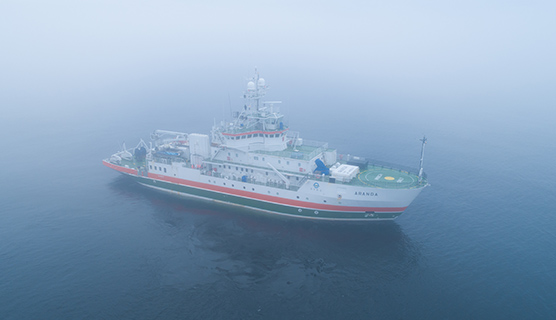
© Ilkka Lastumäki
The Finnish Environment Institute SYKE has again produced an assesment of the state of the coastal waters of the Gulf of Finland and the open sea surrounding Finland from the southern Baltic Sea to the Bay of Bothnia. The state of the Gulf of Finland is better than it has been in the past few years, but the deteriorated state of the Bothnian Sea gives cause for concern.
Towards the end of the summer, the oxygen conditions near the seabed of the Gulf of Finland were better than in the past few years. Entirely anoxic seabed and toxic hydrogen sulphide were observed only at the westernmost sampling point in the Gulf of Finland near the Estonian coast. As the seabed was oxic, the amount of phosphate phosphorus in the water above the seabed was also lower than in the past few years.
- The reason for the better state of the seabed in the open sea area in the Gulf of Finland can be found in the northern part of the Baltic Proper, where the halocline fell deeper last winter. This is still visible as lower salinity and weaker stratification also in the Gulf of Finland. In the measurements conducted towards the end of the summer, increased phosphate concentrations in the central water column were observed only at some stations in the Gulf of Finland compared to the previous ten years, says Research Professor Maiju Lehtiniemi.
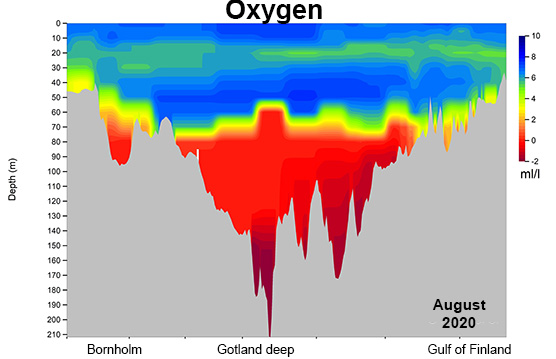
Oxygen situation near the seabed in the open sea from the southern Baltic Sea to the Gulf of Finland. © SYKE Data: SYKE and SMHI
On the coast of the Gulf of Finland, the condition of the seabed was better than usual
The improved oxygen situation in the Gulf of Finland was also reflected in the state of the seabed and the benthic animal communities in the coastal areas and in the outer archipelago. The state of the surface sediment was interpreted to be oxic in almost two out of three of the examined samples. A year ago, the proportion was only just over one third. Benthic animals were observed at 90 per cent of the observation sites. Since 2001, the situation during the monitoring performed at the same observation sites has been better than this only once, says Senior Research Scientist Seppo Knuuttila, who led the monitoring cruise in the coastal waters.
The chlorophyll a concentrations describing the amount of algae were close to the lowest values of the 2000s at the intensive monitoring station of Huovari in the eastern Gulf of Finland in July and August. Compared to the summer of 2018, which saw the worst algae situation of the past decade, the concentrations were on average half lower.
The condition of the Bothnian Sea has deteriorated
- Based on the observations collected in August, the oxygen condition in the Baltic Proper is still poor and the water is anoxic from 70 metres down to the seabed. The anoxic area extends from the southern Baltic Sea to the northern part of the Baltic Proper and up to the mouth of the Gulf of Finland to the east, says Senior Researcher Pekka Kotilainen, the leader of Aranda’s long monitoring cruise.
The amount of oxygen in the basins of the Bothnian Sea was lower than at the same time last year. In some places in the Bothnian Sea, the observed phosphate phosphorus concentrations in the entire water column were higher than the average long-term concentrations for summer. During the cruise, more algae blooms than usual were observed in the Bothnian Sea and Kvarken.
- The most probable explanation for the increased phosphorus concentrations is the more phosphorous water flowing in from the Baltic Proper. The observations indicate changes in the state of the Bothnian Sea. The increasing algae blooms may further weaken the oxygen condition in the Bothnian Sea when the algal mass consumes oxygen in the water layers close to the seabed as it decomposes.
Monitoring data important for assessing the state of the sea
Research vessel Aranda makes four annual monitoring cruises and additional coastal monitoring cruises are made with a smaller vessel. The cruises are part of the SYKE Marine Research Centre's programme for monitoring the long-term changes in the state of the Baltic Sea. They contribute to Finland’s Marine Strategy and the joint HELCOM monitoring conducted by the Baltic Sea countries.
On the monitoring cruises, data on the physics, chemistry and biology of the Baltic Sea are collected from the seabed sediments up to the surface. The collected data can be used e.g. to assess the oxygen condition, eutrophication of the sea and possible changes in the planktonic and benthic communities.
The observations are based on the cruise carried out by research vessel Aranda, the coastal monitoring cruise and the cruise carried out by Svea, the research vessel of the Swedish Meteorological and Hydrological Institute (SMHI) in August.
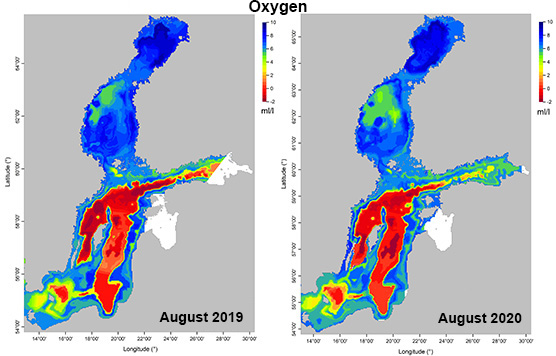
Oxygen situation near the seabed in the open sea from the southern Baltic Sea to the Bay of Bothnia in August 2019 and 2020. © SYKE Data: SYKE and SMHI
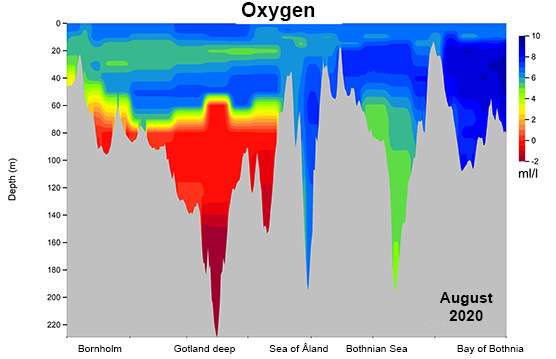
Oxygen profile from the southern Baltic Sea to the Bay of Bothnia in August 2020. © SYKE Data: SYKE and SMHI
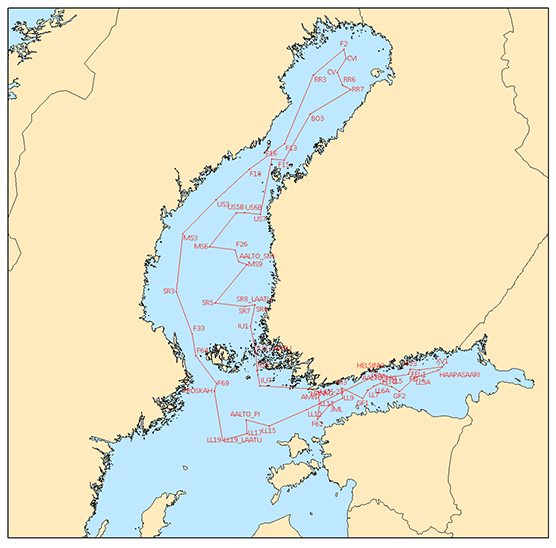
The route of research vessel Aranda’s monitoring cruise in August 2020. © SYKE
Further information
- Gulf of Finland: Maiju Lehtiniemi, Research Professor, Finnish Environment Institute SYKE, tel. +358 (0)295 251 356, firstname.lastname@ymparisto.fi
- Gulf of Finland coastal monitoring: Senior Research Scientist Seppo Knuuttila, Finnish Environment Institute SYKE, tel. +358 (0)295 251 286, firstname.lastname@ymparisto.fi
- Gulf of Bothnia and Archipelago Sea: Senior Researcher Pekka Kotilainen, Finnish Environment Institute SYKE, tel. +358 (0)295 251 317, firstname.lastname@ymparisto.fi
- Communications Manager Sirpa Mäkinen, Finnish Environment Institute SYKE, tel. +358 295 251 587, firstname.lastname@ymparisto.fi
Pictures for media use